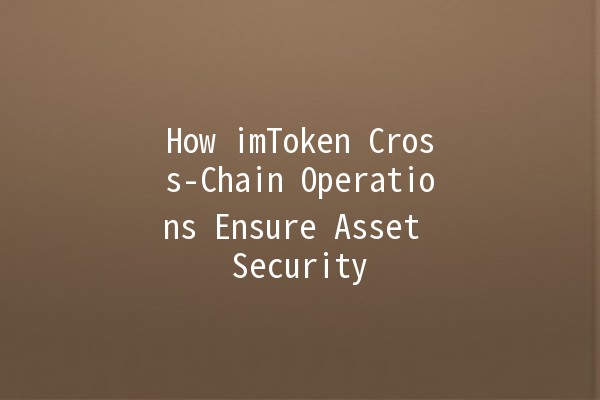In the current landscape of decentralized finance (DeFi), the ability to securely and efficiently manage assets across different blockchains is paramount. As crosschain transactions become more prevalent, ensuring the safety of assets during these operations is critical for users relying on platforms like imToken. This article explores effective tips and strategies for safeguarding assets during crosschain operations.

imToken is a popular digital wallet that supports multiple cryptocurrencies and facilitates crosschain transactions. Crosschain operations allow users to transfer assets between different blockchain networks, significantly improving liquidity and accessibility. However, these operations expose users to potential risks, including hacks, loss of funds, and transaction errors. Understanding how imToken addresses these challenges can empower users to navigate the decentralized environment more safely.
Multisignature (multisig) wallets require multiple private keys to authorize a transaction. By using a multisig wallet, users can significantly reduce the risk of unauthorized access.
How to implement:
Choose a multisig wallet supported by imToken.
Set it up so that a majority of designated signers are necessary for approvals.
Regularly update the list of authorized keys to ensure security.
Example: A partnership of three individuals can create a multisig wallet that requires at least two signatures for any transaction. This layer of security protects against losses from a single compromised key.
Before initiating any crosschain transaction, users should conduct a thorough audit of their smart contracts to identify potential vulnerabilities.
How to implement:
Engage thirdparty security experts who specialize in blockchain.
Test the contracts on a testnet before deploying on the mainnet.
Ensure the audit includes examining previous vulnerabilities and potential exploits.
Example: A project planning to utilize a bridge for crosschain operations commissioned a security audit. The auditors identified and mitigated vulnerabilities in the smart contracts, leading to a successful and secure launch.
Implementing timelocks on transaction executions can add an additional layer of security against unintended trades or unauthorized access.
How to implement:
Configure the transactions to delay execution until a specified time frame.
Notify all stakeholders of the impending transaction to scrutinize it.
Ensure that timelocks are appropriately set based on the urgency and importance of the transaction.
Example: If a transaction involving significant amounts is scheduled, a timelock of 12 hours allows participants to review the transaction, ensuring it aligns with expectations before execution.
Regularly updating the wallet software and any related applications is vital for maintaining security health, as updates often patch security vulnerabilities.
How to implement:
Enable automatic updates when possible.
Stay informed about the latest releases from imToken and relevant software.
Regularly review and implement security best practices as outlined by the developments in the wallet software.
Example: A user who kept their imToken wallet updated could avoid exploits that targeted older versions of the software, ultimately preserving the safety of their assets.
Phishing is a common tactic used by malicious actors to gain access to users' private keys and sensitive information.
How to implement:
Educate users about recognizing phishing attempts and scams.
Use only official channels and resources for information related to imToken.
Encourage the implementation of twofactor authentication (2FA) where possible.
Example: An organization hosted training sessions for its users, explaining how to identify fraudulent emails and suspicious links, significantly decreasing the likelihood of successful phishing attacks.
Crosschain operations present several risks, including smart contract vulnerabilities, potential hacks on the bridging technology, and exposure to erroneous transactions due to human error. Users must be aware of these risks and implement preventive measures to mitigate them effectively.
imToken employs various security measures, including robust encryption protocols, secure storage solutions, and userfriendly designs that guide users towards safer practices. Moreover, the wallet's multichain infrastructure is built with security in mind, providing features that enhance crosschain operation safety.
Recovery of assets is possible if you have your recovery phrase (seed phrase). As imToken adheres to best practices in wallet security, retaining your recovery phrase is crucial for regaining access to your wallet in case of device loss or theft. If you suspect a security breach, immediately initiate the recovery process.
While imToken aims to provide efficient transactions, the speed of crosschain asset transfer can vary based on network congestion and the protocols used. Users should check the current status of the networks involved for realtime updates.
Yes, crosschain transactions may incur network fees that vary depending on the blockchain networks' gas fees being used for the transfer. Additionally, imToken may have its own service fees for handling the transaction, which users should be aware of before proceeding.
Users should regularly update their software, utilize strong passwords, enable twofactor authentication, and remain vigilant against phishing attempts. Following best practices ensures that wallets remain secure against evolving cybersecurity threats.
Navigating the world of crypto and crosschain operations can be daunting, but with the right knowledge and practices, users can enhance their asset security. Implementing security techniques like multisignature wallets, thorough audits, timelocks, software updates, and phishing awareness leads to a more secure experience with imToken. By adopting these strategies, individuals can confidently participate in the growing landscape of decentralized finance while safeguarding their assets.